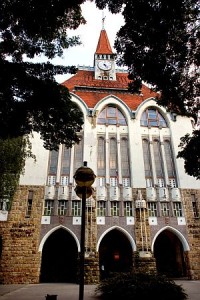Kecskemét
Kecskemét – the capital of Bács-Kiskun County – comprising all the beauty and values of the Great Plain is situated in the middle of Hungary, approximately 85 kms from Budapest, and is the 7th largest town in Hungary with an area of 321 km2 and a population over 112,000. Thanks to its favourable geographical location, the city is the economic, administrative, educational, and cultural centre of the region, hosting numerous institutions of fine arts, unique collections, and festivals.
The name of the city originates from the word „kecske” (meaning „goat”) and „mét” (meaning district). The goat can be seen in the coat of arms as well above the platform of the Town Hall with the motto of the city beneath: „Neither height, nor depth frightens us.”
Kecskemét is one of the few cities in Hungary with a significant Art Nouveau architectural heritage, bringing a special flavour to the downtown together with the magnificent Zsolnay ceramics and tiles decorating many of the public buildings.

The Town Hall in the Main Square is one of the best-known buildings of Kecskemét, and is considered as the pearl of Art Nouveau. It was built between 1893-1897 by the famous Hungarian architects Ödön Lechner and Gyula Pártos.
Since 1983, a carillon on the facade of the building plays the works of Kodály, Erkel, and great Western music every hour.
An interesting curiosity of the breathtakingly beautiful Main Square is that almost all religions' churches can be found here as a sign of understanding and acceptance.
Opposite the Town Hall you can find the oldest architectural relic of Kecskemét, the Franciscan Church built in the 14th century, known to the locals as the Church of Friars. Originally it was built in Romanesque style, and after several reconstructions it has gained its current Baroque character. Adjacent to the church is the Kodály Institute, located in the Franciscan monastery at Kéttemplom köz (meaning the "alley of two churches") since 1975. At the end of the street we find the Calvinist Church built in early Baroque style in the 1680s, the only stone church in the region constructed during the Turkish occupation.
The largest church is the Big Catholic Church, which was built between 1774-1806, has a bell weighing 2400 kg. 94 steps take you up the 74 m tall tower to enjoy an aerial view of the city, with its protruding steeples and domes.

Opposite the Calvinist Church is the New College, erected in 1912. The palace was also built in Art Nouveau style, and decorated with Transylvanian motives. It hosts the Primary and Secondary Grammar School of the Calvinist College, one of the Model Schools of the Kodály Institute as part of the ”Kodály revisited in the 21st century”. The project aims at appointing schools to become partners and model schools in safeguarding and excelling in the Kodály concept in the 21st century.
There are two famous buildings to the right of the New College: the first is Cifrapalota (Ornamented Palace), a unique piece of architecture known as another masterpiece of Art Nouveau with its wonderful „waving” walls, shining roof tiles and ceramic ornamentation depicting plants and animals. Today it hosts the Kecskemét Art Gallery.
The other building is the one-time synagogue built in Moorish-Romantic style between 1861-1864. It was converted into a conference centre in the 1970s called the House of Science and Technology.
Besides the Kodály Institute, the Kecskemét Symphony Orchestra, the József Katona National Theatre, the Leskowsky Musical Instrument Collection, numerous award-winning choirs and music festivals all year round hallmark how important a role music plays in the life of city, the hometown of Kodály, and the first place in Hungary where a singing primary school was established.
The list of museums and workshops of the city covers a wide range of genres, including collections of fine art in the Cifrapalota, the Museum of Naive Artists, the Hungarian Museum of Photography, the International Ceramics Studio, the International Enamel Art Workshop, the "Szórakaténusz" Toy Museum and Workshop, the Ráday Museum of the Hungarian Reformed Church and the Ciróka Puppet Theatre.
The Kecskemét Film Animation Studio has won international fame and recognition by producing numerous award winning animation films and now has established connections with the Hollywood animation industry.

Among the town's most popular recreational and excursion spots are the wonderful 62 hectare Kecskemét Arboretum and the Kecskemét Bath with its indoor and open air swimming and leisure pools. Both places are well liked by the students of the Kodály Institute.
Kecskemét offers a wide variety of cuisines, among them many authentic restaurants featuring genuine Hungarian meals.
The economy of Kecskemét has recently been boosted by significant international industrial investments, making the city one of the fastest growing in Hungary. In 2012 the Mercedes Benz car company opened a huge manufacturing plant and brought the production of CLA models and B-class models to Kecskemét. A few years later the expansion of the plant was finished and production of the A-class models was added to the line. Production reached the milestone of 1 000 000 cars in 2018. The company has also established various educational and social institutions and has become the largest employer of the city.
The other significant investment was made by the Munich-based Knorr-Bremse Group, which is the world’s leading manufacturer of braking systems and supplier of additional sub-systems for rail and commercial vehicles.
The Kecskemét-based traditional Hungarian companies are also doing excellent business.
To read more about the city’s history and sights or see more photos, please visit this website: https://www.iranykecskemet.hu/en



